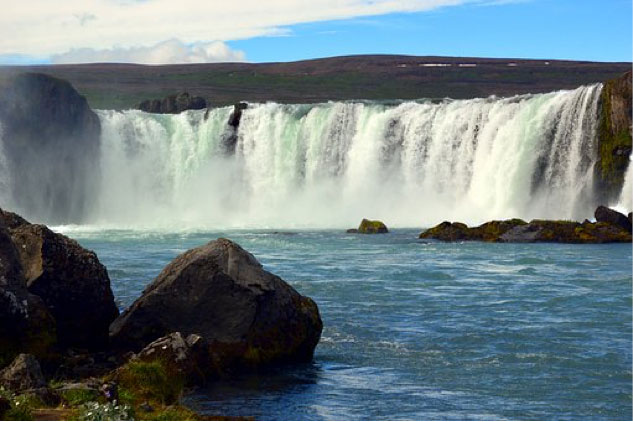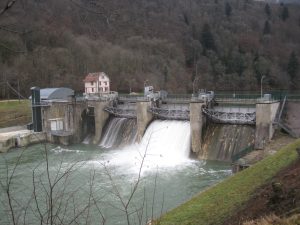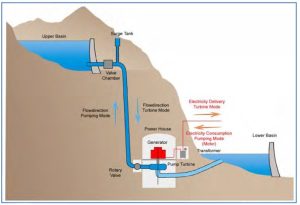The balance of the electrical network requires a storage capacity that, at present, only hydroelectricity can provide adequately. What techniques can be used? With what advantages and disadvantages? According to what spatial distribution in Europe?
Hydroelectricity is based on a simple concept: to take advantage of the gravitational energy produced by the fall and the flow of bodies of water in order to convert it into mechanical and then electrical energy by means of a turbine-generator set.
The creation of a reservoir upstream allows the water to be stored, thus a potential energy, then to be turbined and electricity produced on demand (Read: Hydraulic works). The addition of a pumping function also makes it possible to transform excess production, for example from wind farms or photovoltaic systems, into potential energy stored in the reservoir and usable during periods of high demand (Read: Pumping stations (STEP)).
This capacity for reversible transformation of potential energy into electrical energy, combined with the great flexibility of hydroelectric installations, makes hydraulic storage not only the leading mode of energy storage in the world (between 94 and 99%, depending on the source, of total energy storage capacity) but also a valuable tool for the management of electrical networks (Read: The breakthrough of electrical storage: What techniques? What economic functions? What future?).
1. Context of hydraulic storage problems
Two important developments in the energy sector should be considered in the interest of hydraulic storage: on the one hand, the regulatory context and, on the other hand, the context of energy decarbonisation.
1.1. The regulatory context
The regulatory context is crucial to understanding the value of storage. In the early 1990s, both the European Union and the United States began a profound transformation of the electricity market from monopolistic, partially state-owned, vertically integrated utilities to a segmented and competitive market (see: The Complexity of Electricity Markets).
To enable this transition, the regulatory framework has set rules for unbundling the electricity sector combined with differentiated regulation of segments of its value chain: generation, wholesale, transmission, distribution and retail (Figure 1).

Of these segments, only transmission and distribution remain regulated natural monopolies. Generation, trading and retailing are open to competition and subject to market rules.
The balance of the system (production-consumption balance) and the quality of the energy supplied (frequency, voltage) are the direct responsibility of the TSO (Transmission System Operator). The TSO is generally not allowed to own generation assets that could provide the services to guarantee the balance between supply and demand. It will therefore require services (e.g. reserve market) or impose obligations (e.g. generation reporting obligations on producers) to ensure this balance.
It is in this context that the storage function appears at different levels, in particular by making new competitive markets emerge.
The demand for large-scale storage is of interest to the wholesale sector and trade as well as transmission.
Generation market arbitrage consists of on-load storage when electricity prices are low and off-load storage at times when prices are high. The price differences are usually the result of system load and, increasingly, the supply of intermittent generation from wind and solar PV.
The reserve market is a somewhat special case in a deregulated energy system. The unbundling of the energy sector has indeed created opportunities for providers of ancillary and reserve services, such as frequency control, secondary and tertiary reserve or various other services. However, this market segment is largely influenced by how it is paid for.
The importance of the regulatory and therefore economic structure of the electricity market value chain in valuing the storage function is such that any change in this structure will significantly affect the nature and economic value of storage.
1.2. The context of energy decarbonisation
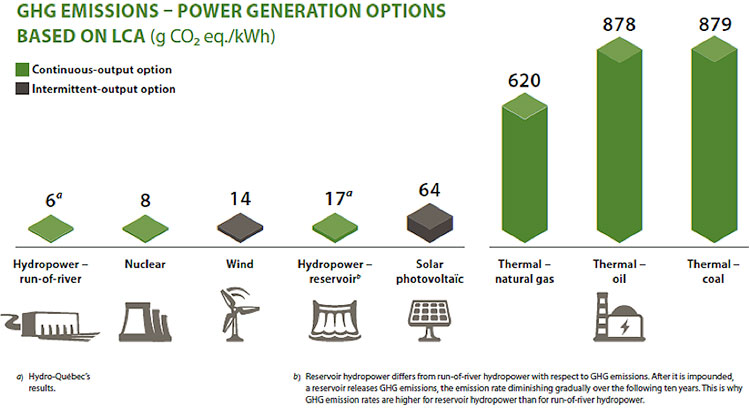
The European Union (EU) energy policy is very much oriented towards the objective of decarbonising the economy. Various scenarios are envisaged to reduce greenhouse gas (GHG) emissions by 80-95% by 2050, compared to their 1990 level[1]. 1] To reach this objective, the contribution of the energy sector, which is responsible for 75% of GHG emissions,[2] is fundamental, particularly in the form of an increase in the contribution of renewable energy sources (RES), which are low emitters of greenhouse gases (GHG) (Figure 2). They are led by wind and solar energy, but also by hydroelectricity, albeit with less growth.
Among the renewable sources used to produce electricity, hydroelectricity is the most important, but from 2005 to 2016, its share declined from 71% to 47% of all so-called renewable electricity (Figure 3).
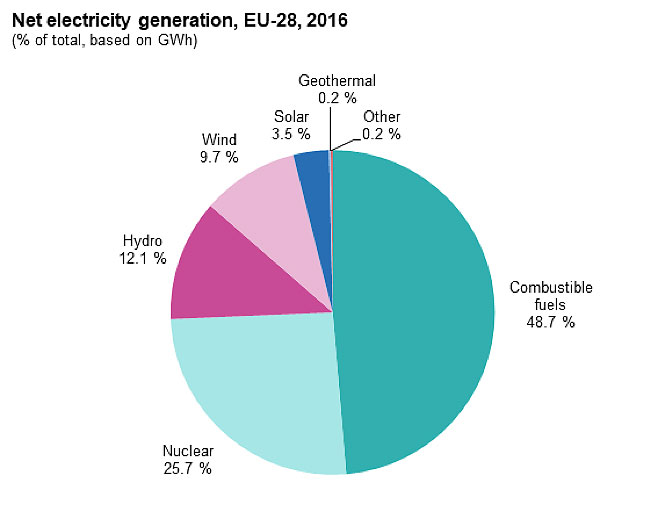
In the future, its production will continue to increase, but its share in the electricity mix will further decrease due to the stronger growth of other renewable sources, wind and solar. According to the National Renewable Energy Action Plan
(NRAP), adopted by the EU in 2010, installed hydroelectric capacity would increase from 115 GW to 135 GW between 2005 and 2020, with an additional production per year of only 23.5 TWh, i.e. a production of 370.3 TWh (Figure 4).
<img class=”aligncenter wp-image-9370″ title=”Fig. 4: Hydropower in the EU-27 in 2005 and 2020 (NREAP plan). RES electricity will account for 42.6% of all RES sectors in 2020 (in heating and cooling with 45.4%, the rest in transport).” src=”https://www.encyclopedie-energie.org/wp-content/uploads/2019/03/fig4_Situation_reference_2005.jpg” alt=”Fig. 4: Hydropower in the EU-27 in 2005 and 2020 (NREAP). RES electricity will represent 42.6% of all RES sectors in 2020 (in heating and cooling with 45.4%, the rest in transport).” width=”613″ height=”420″ />
&nbp;
However, it should not be forgotten that the integration of the so-called fatal sources, electricity from wind and photovoltaic sources, can only be achieved through the use, at different levels, of means of regulation and energy storage, among which hydropower will make a major contribution.
2. The role and different levels of energy storage in the electrical system
Energy storage systems intervene at different levels of the power system: generation, transmission, distribution, consumption, their specific characteristics varying according to the uses.
2.1. Advantages of storage
If, fundamentally, the role of storage is to reconcile the variability of production with the variability of consumption, we will distinguish applications according to whether the aim is to have a power reserve or an energy reserve. In the first case, it is a question of being able to inject a high level of power for a short period of time, counted in minutes or even seconds; in the second case, it is a question of having a reserve of energy that can be made available over a long period, counted in hours.
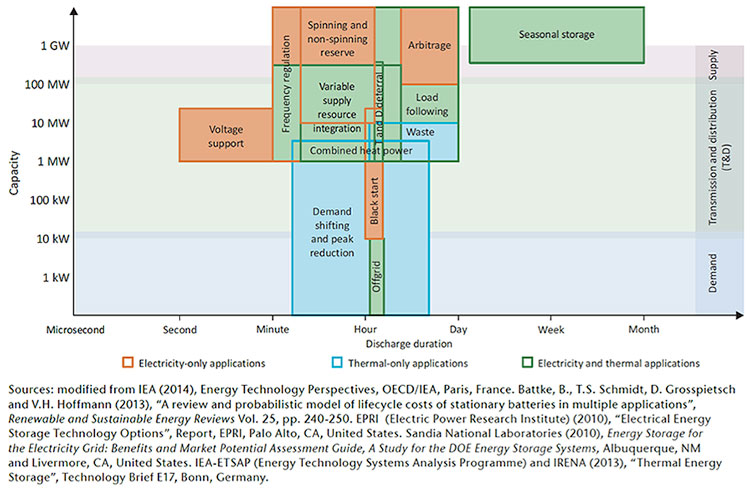
There are various storage technologies ( Read: The breakthrough of electrical storage: Which techniques? What economic functions? What future?). They transform electricity into another form of energy that can be stored and then converted back into electricity. Systems competing with hydro store electricity in the form of compressed air, natural gas, hydrogen, fuel cells, heat or inertia (flywheels). These various forms of storage can be classified according to their power/discharge time characteristics and their positioning in the power system (Figure 5).
In detail, the needs identified are mainly:
- seasonal storage ;
- market arbitrage, i.e. storage of energy produced in low-cost periods for resale in high-cost periods;
- auxiliary services (or system services): the key parameters that must be controlled to ensure a stable flow of electricity are frequency, voltage and reactive power, as well as the system’s inertia or spinning reserve, factors that allow for the proper balance between variables and dispatchable generation;
- integration of intermittent generation sources;
- the constitution of reserves to make up for the sudden failure of centralised generation resources in order to avoid load shedding operations;
- to these needs must be added the so-called black start capacity, i.e. without any external energy source.
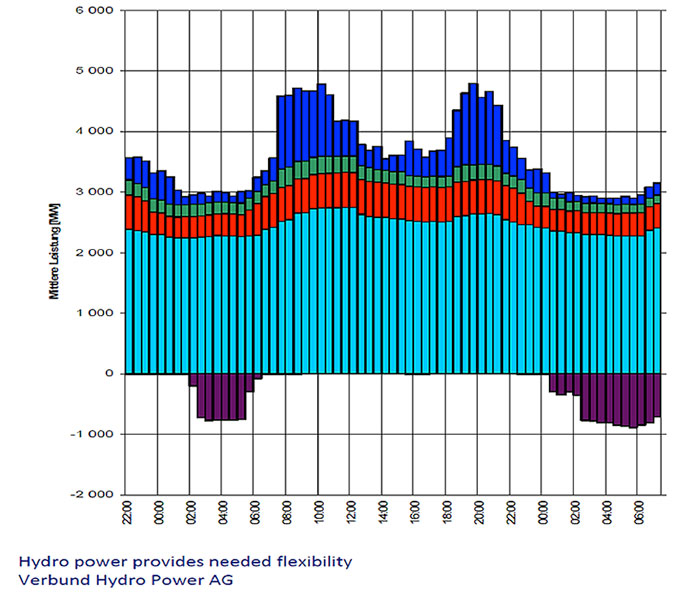
Several benefits are expected from storage.
- For production: storage offers energy capacity possibilities for the entire energy sales and arbitrage market. From the perspective of the energy transition, this amounts to subsidising and fixing fixed tariff systems for renewable energies (RES) by becoming a market-driven product system. Storage is needed to compensate for intermittency, to improve the availability of RES generation, especially with regard to the non-generability of stabilised renewable energy generation.
- For the transmission and distributionnetwork: storage facilities can contribute to an increase in the rate of utilisation of network carry-over and investments;
- For load (consumption): storage facilities can help shift peak electricity demand, leveling out asset loads, improving usage and consumer service (Figure 6).
Hydraulics can provide long-term regulation with a wide range of solutions (high and low head, marine or loop potential), and gas storage can be developed for suitable cases.
Not all power generation technologies have the same technical flexibility when it becomes necessary to balance fluctuations in demand or to provide backup capacity for RES.
2.2. Small-scale or decentralized storage
Decentralised or distributed energy storage refers to systems connected to the grid at low or medium voltage. These are installed close to consumption centres, renewable energy production sources, integrated on the distribution circuits. In this case, the integration of decentralised storage into the distribution network needs to be agreed between the actors, especially regarding the connection of storage facilities and access rights. This requirement is a source of uncertainty on service guarantees for suppliers. Therefore, to facilitate the development and integration of storage, Eurelectric makes several recommendations:
- decentralized storage should be considered as part of the development of a smart electricity system;
- decentralised storage could serve the interests of the market as well as the distribution system operators (DSO), which implies that the market models, roles and responsibilities of the actors involved are clearly designed;
- decentralised storage is not a silver bullet for a more efficient and stable grid, but it needs to be evaluated and compared to other flexibilities options such as demand side participation or back-up generation;
- european storage research funding should focus on key technologies that promote the integration of storage systems into the electricity grid;
- a holistic approach taking into account all costs and benefits is needed to achieve the EU’s energy objectives and smoothly integrate distributed generation technologies into the smart electricity system;
- the tariff system should be reviewed in the context of a smart grid.
2.3. large-scale storage
The operation of large water reservoirs and pumped storage plants offers a unique position of leadership in large-scale storage. Its assets are indeed the energy performance (high overall conversion efficiency) as well as the investment cost (long life and mature technology) and operating cost (operating and maintenance costs -O&M, failure rate, predictability of the resource).
Massive hydraulic storage thus offers the possibility of storing surplus electrical energy and responding reactively and with large capacities to supply and demand variability. Massive storage technologies are able to inflect the fatal and intermittent nature of RES over significant periods of time, with a strong capacity to adapt to market needs by decoupling energy production and consumption.
3. Estimating the need for storage
During the 1980s, particularly in France, the significant development of hydraulic storage was linked to the development of nuclear energy, which was not very flexible at the time. On the eve of the 2020s, it is the increase in the share of electricity production from intermittent sources (wind and photovoltaic) that justifies the increase in storage capacity.
Assessing the storage needs related to this development is difficult insofar as these needs depend on several factors: the proliferation of intermittent sources linked to their geographical distribution and therefore subject to different climates; changes in the types of consumption, which depend on the ability of consumers to adapt to production conditions, which would be the case, for example, for recharging electric vehicles; and the level of network meshing and the relative cost of storage compared to controllable means of production, such as gas-fired power plants.
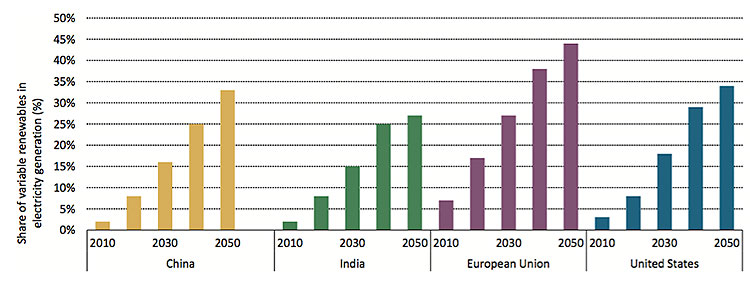
An assessment of these needs has been carried out by the International Energy Agency (IEA) based on a so-called 2DS scenario which aims to limit the increase in average temperature to 2°C compared to the pre-industrial era, by increasing the share of renewable energies in electricity production to nearly 45% in the case of the EU (Figure 7).
Given the already exploited potential of hydropower, this objective can only be achieved through the development of intermittent sources, which automatically leads to an increase in the need for energy storage. Still for the EU, this need was evaluated at 70 GW by 2015, but it could be reduced to 50 GW in the event of significant development of the electric vehicle (EV) fleet and intelligent management of their charging (Figure 8). On the other hand, this need could have reached 90 GW in a Breakthrough Scenario
assuming a drastic decrease in the cost of daily storage, thus making it more competitive than the means currently used to ensure the balance of the grid by combined cycle gas power plants.
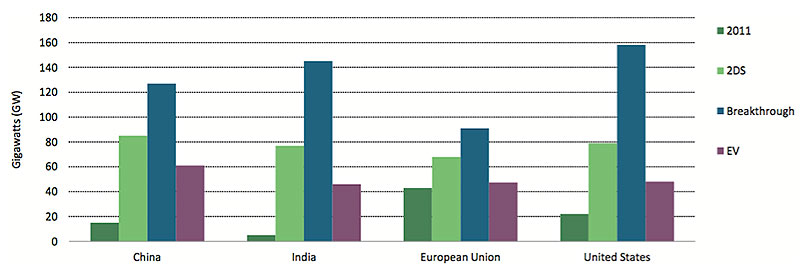
Other evaluations of storage needs, in the longer term, are based on the percentage of integration of intermittent energy sources. The European Associationfor Storage of Energy
(EASE) has compiled these (Figures 9 and 10).
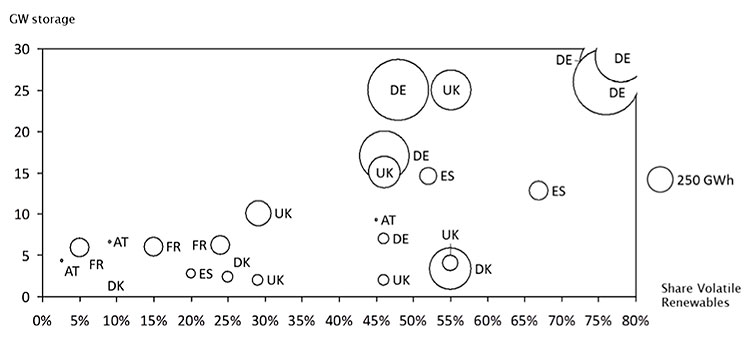
The dispersion of the results of these studies reveals the difficulty of anticipating changes in energy production and consumption patterns. In any case, an increase in storage needs remains inevitable in the context of an increase in intermittent decarbonated sources.
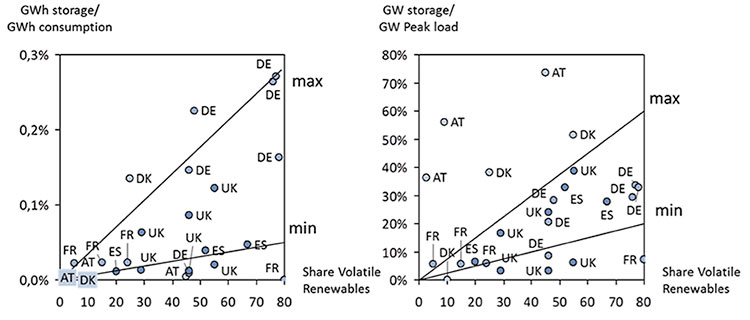
4. The different forms of hydraulic storage
We can distinguish three types of hydroelectric power stations capable of producing energy storage: the power stations of the so-called “lake” hydroelectric schemes, the power stations of the “run-of-river” hydroelectric schemes, and the pumping-turbine hydroelectric schemes (Read: Hydraulic works). The storage capacities of the various types of facilities are very different.
4.1. Hydroelectric facilities known as “lake” facilities
The hydroelectric power plants known as “lake” are developments for which a structure (dam) has been built to constitute a water reserve (reservoir) sufficient to regulate the flow of the watercourse throughout the season or the year. Hydroelectric power plants with large reservoirs can even provide flow regulation on a multi-year basis (Read: Large hydroelectric schemes: Génissiat (I) and Large hydroelectric schemes: Génissiat (II)).
In mountainous areas, natural water bodies can also be used as reservoirs.
These reservoirs are connected to the hydroelectric power plants by tunnels, galleries, penstocks, thus making it possible to obtain significant heads: more than 1,800 m for the Bieudron power plant for example (Read: Hydroelectricity: the penstocks of the Bouchayer-Viallet company in Grenoble).
These high heads make it possible to obtain high power, even with low flows. The creation of a reservoir on a river with a low flow makes it possible to produce a high power for a short period. These facilities are reserved for peak production.
Reservoir-type power plants can also be built in the upper reaches of a river with a chain of run-of-river facilities downstream. The lockage from the upstream reservoir plant is then turbined by the downstream facilities.
Small reservoir hydroelectric plants are designed to modulate generation on a daily or weekly basis and can provide flexibility services primarily through balancing power.
Large reservoir hydroelectric plants offer a very high level of service, allowing large-scale energy storage during periods of low demand (natural reservoir refill) and can make this energy immediately available by turbining when demand rises, for example during periods of peak consumption. Their fast response time of less than five minutes allows them to respond instantly to sudden fluctuations in demand.
No other power generation system can offer a comparable level of service. These plants also provide the full range of ancillary services, including frequency and voltage control and black
start capability. This start-up capability is a key asset in the event of a total collapse of power generation. A group of hydroelectric power plants is thus ready to carry out the task of exciting a major transmission line (so-called voltage return function) and to be able to relieve a network.
This type of facility cannot store electrical energy already produced by other means when demand is low, it can only store potential energy.
4.2. Run-of-river” hydroelectric facilities
By definition, a “run-of-river” power plant has no storage capacity. Built in the river bed, it uses its so-called natural flow, although it may be influenced by developments located further upstream. In practice, this type of power plant has only a small storage capacity, of the order of two hours, at the average flow of the river, for example (Read: Run-of-river hydropower: from project to operation).
Run-of-river power plants therefore only offer short-term storage possibilities, allowing some adaptation to demand, especially for ancillary services such as frequency and voltage control or shifting part of their production from low consumption hours to peak hours.
In the case of a chain of run-of-river facilities, optimised management, taking into account transfer times between facilities and their storage capacity, makes it possible to carry out synchronous lockage from, for example, a reservoir-type facility located upstream.
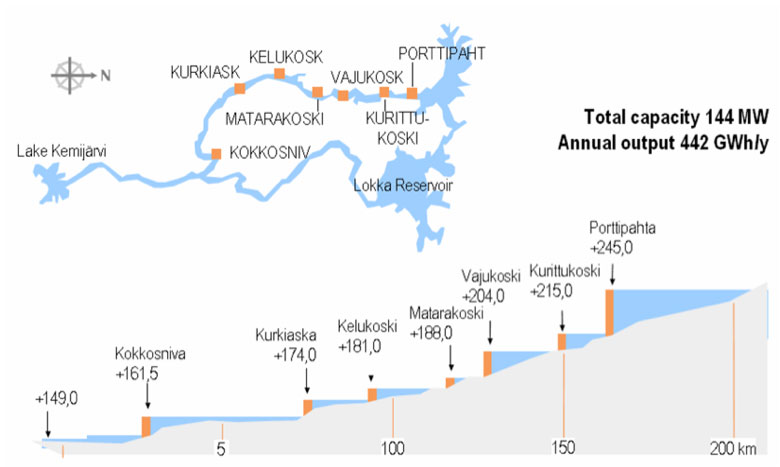
Conversely, a constant load from a run-of-river hydropower plant is possible if the river is already regulated upstream by a hydropower plant with storage capacity through its reservoir. This strategy is commonly used to optimize hydroelectric power generation on a river provided a large storage reservoir is built in the upper watershed that can equalize flows for multiple run-of-river plants with small plants as the reservoir is approached downstream (Figure 11).
As with lake schemes, run-of-river schemes cannot store electrical energy already generated by other means when demand is low, they can only store potential energy.
4.3. Pumped-storage hydroelectric schemes
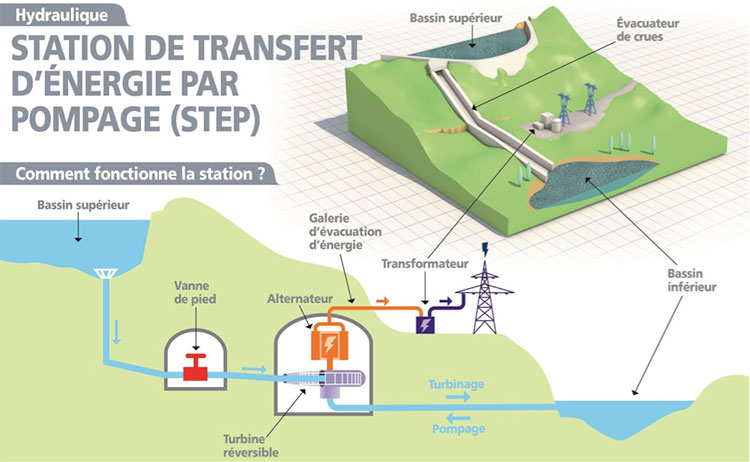
Pumped Storage Plants (PSP) operate between an upper and a lower reservoir (Read: Pumped Storage Plants (PSS)).
In production mode, water is released from the upper reservoir to the lower reservoir through the turbines to produce electricity in periods of high demand. In pumping mode, water is pumped from the lower to the upper reservoir using surplus or low cost energy (wind, photovoltaic, nuclear) during periods of low consumption. In contrast to lake or run-of-river schemes, WTPs are therefore able to store electricity that has already been generated (Figures 12 and 13).
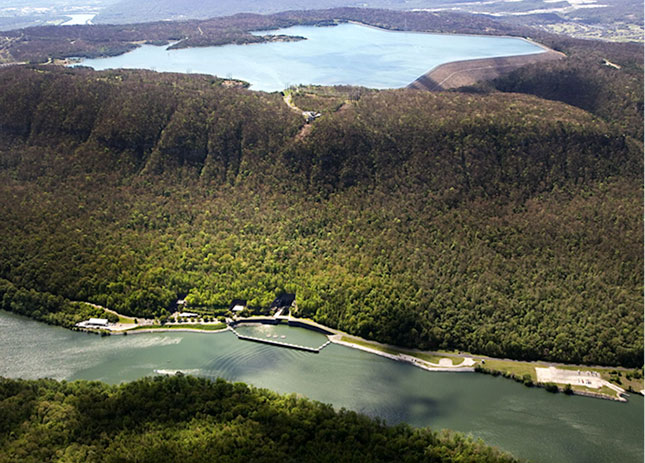
Depending on whether one of the reservoirs is part of the natural river system, or both reservoirs are storage ponds, pumped storage at hydropower plants can fall into either of two categories:
- mixed pumped storage with natural inflows ;
- pure pumped storage system, on artificial reservoirs, without external input.
These plants are characterized by:
- the installed capacity (from a few MW to more than 1,000 MW);
- the storage capacity of the two reservoirs,
the characteristics that allow determining the type of operating cycle of the plant.
Pumped storage plants are generally operated on daily or weekly cycles (Figure 14).
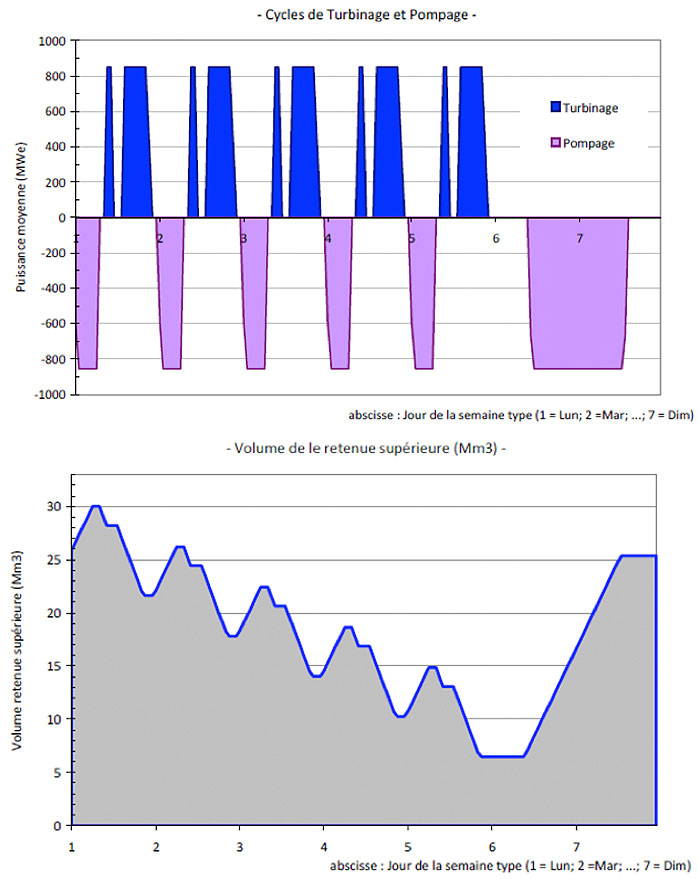
Notes and references
[1](https://ec.europa.eu/clima/sites/clima/files/docs/pages/com_2018_733_en.pdf)
[2] (https://ec.europa.eu/clima/sites/clima/files/docs/pages/com_2018_733_en.pdf
Additional bibliography
[1] Argonne National Laboratory (2013). Modeling Ternary Pumped Storage Units. Available at https://www.osti.gov
[2] Avellan F. (2012). Evolution of pumped storage units. Current situation, technologies and new projects. Bulletin Electro-suisse 2/2012 pp. 37-40.
[3] EASE/EERA (2017). European Energy Storage Technology Development Roadmap 2017 update. Available at http://ease-storage.eu
[4] European Environment Agency (2018). Renewable energy in Europe – 2018 Recent growth and knock-on effects. Available at https://www.eea.europa.eu/
[5] Eurelectric (2015). Hydropower supporting a power system in transition. Available at https://www.eurelectric.org
6] Eurelectric (2011). Hydro in Europe: Powering Renewables. Full report and annexes. Available at https://www.eurelectric.org
[7] International Energy Agency (2014). Technology Roadmap. Energy Storage. Available at https://www.iea.org
[8] European Commission. Joint Research Center (2012). Pumped-hydro energy storage: potential for transformation from single dams. Available at https://ec.europa.eu/jrc/en
[9] European Commission. Joint Research Center (2013). Assessment of the European potential for pumped hydropower energy storage. Available at https://ec.europa.eu/jrc/en
[10] European Commission. Joint Research Center (2013). Assessing Storage Value in Electricity Markets. Available at https://ec.europa.eu/jrc/en
The Encyclopedia of Energy is published by the Association des Encyclopédies de l’Environnement et de l’Énergie(www.a3e.fr), contractually linked to Grenoble Alpes University and Grenoble INP, and sponsored by the Academy of Sciences.To cite this article, please mention the author’s name, the title of the article and its URL on the Encyclopedia of Energy website. The articles of the Encyclopedia of Energy are made available under the terms of the license Creative Commons Attribution– Noncommercial – No Derivative Works 4.0 International.



